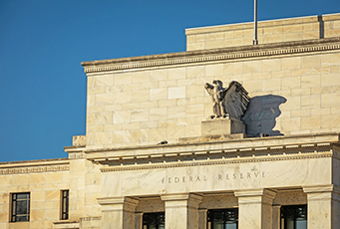We are more than a year into the Federal Reserve's campaign to tame inflation with aggressive interest rate hikes. A recession was widely expected. However, economic data continues to come in hotter than forecast and the key signs of recession remain elusive. Is the Fed on pace to achieve the desired "soft landing" that curbs inflation while avoiding recession? Or, is a recession still looming in the near future?
Pausing…For Now
In their June 2023 meeting, the Federal Reserve left benchmark interest rates unchanged. This decision comes after ten consecutive rate increases dating back to March 2022, which saw the federal funds rate go from near 0% to the current range of 5% to 5.25%.
The Fed began aggressively raising interest rates in response to soaring inflation as consumers emerged from the Covid-19 pandemic with pent-up demand and excess cash, partly caused by reduced spending during the pandemic plus windfalls of government stimulus payments.
At first, the resulting high inflation readings were interpreted to be "transitory" by the Federal Reserve, meaning they expected just a temporary jolt of inflation that would naturally cool off quickly once supply chains worked through backlogs and consumers worked through pent-up demand from pandemic restrictions. However, the inflation readings continued to trend upward, and it became clear that inflationary pressures were not transitory and the Federal Reserve needed to aggressively tighten monetary policy, or raise benchmark interest rates, to fight inflation.
The potential ripple effect of aggressive tightening is that the economy can be slowed down too much and enter a recession.
Inflation Data Cooling
The May 2023 consumer price index (CPI) reading showed a 4% year-over-year increase, down from April's reading of 4.9% and less than half of the recent peak reading of 9.1% in June 2022—the highest in the last 40 years. The Fed's long-term target for a healthy level of inflation is 2%.
The stickier component of inflation, which is why the Fed is signaling more rate hikes ahead, is core CPI. The May 2023 Core CPI reading showed a 5.3% year-over-year increase, which remains elevated compared to the overall CPI. Core CPI is the overall CPI minus energy and food prices, which tend to be the more volatile components of inflation data.
Stripping out the more volatile components is considered a better predictor of future inflation.
Economic Data Not Cooling...Yet?
While recent data shows directional progress in taming overall inflation, it is clear that the Fed does not want progress to be confused with "mission accomplished." In their June meeting, Federal Reserve Chair Jerome Powell signaled that they would potentially need to raise rates twice more in 2023 if inflation remains stubborn.
Another headwind for the Fed's objective of taming inflation is the labor market. A strong May jobs report suggests that the U.S. economy is maintaining momentum despite persistent inflation and rising interest rates. Recent U.S. Bureau of Labor Statistics data shows there are still more job openings than unemployed persons in the economy.
What it Means for Investment Returns
Stocks have rallied in 2023, with the S&P 500 index gaining over 15% for the year as of mid-June. Investors seem to be doubting central banks' hawkish tone and anticipating rate cuts in 2023 instead of rate hikes.
Some economists believe that is a mistake and that markets underappreciate the central bank's commitment to reducing inflation to 2%. If that is the case, markets could be in for a bumpy second half to 2023.
Conclusion
The economic direction moving forward is uncertain. Based on the current data, the bulls and the bears can each make a believable case. We can see that the Fed's interest rate decisions have resulted in lower inflation, but the full effects of their moves over the past year have yet to be seen.
As we continue to monitor the inflation and economic data coming in, it is important to make sure your portfolio can withstand a bumpy ride should interest rates need to go higher than anticipated and tip the economy into a recession.
Schedule a Consultation
We have helped our clients answer these questions and more. If you want a clear understanding of your financial future, and need help making changes to reach your goals, schedule a consultation and we can get started.
The material has been gathered from sources believed to be reliable, however Bedel Financial Consulting, Inc. cannot guarantee the accuracy or completeness of such information, and certain information presented here may have been condensed or summarized from its original source. To determine which investments or planning strategies may be appropriate for you, consult your financial advisor or other industry professional prior to investing or implementing a planning strategy. This article is not intended to provide investment, tax or legal advice, and nothing contained in these materials should be taken as such. Investment Advisory services are offered through Bedel Financial Consulting, Inc. Advisory services are only offered where Bedel Financial Consulting, Inc. and its representatives are properly licensed or exempt from licensure. No advice may be rendered unless a client agreement is in place.
Recommended Articles
2026 Market Outlook: Themes, Risks, and the Reality of Uncertainty
Several firms, including WisdomTree, BondBloxx, and...
Private Equity and M&A in a Low-Rate World
Deal flow is the stream of business proposals, investment...





